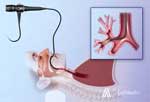Treatment hope for asthma sufferers
Published: 29 March 2007
Research by scientists at the University of Glasgow has shown a new treatment for asthma sufferers can make a major impact on their condition
Professor Neil Thomson found that patients treated with heated air directly into the lungs demonstrated an overall improvement in asthma control, according to a report published in this week's edition of the prestigious New England Journal of Medicine (NEJM).
The publication entitled, 'Asthma Control during the Year after Bronchial Thermoplasty' showed that patients treated with bronchial thermoplasty, as compared to a control group that did not receive the out-patient procedure, demonstrated a statistically significant:
- decrease in asthma attacks,
- increase in days with no asthma symptoms,
- improvement in asthma-related quality of life,
- reduction in rescue medication use (short-acting bronchodilators), and
- improvement in asthma control.
The study report, co-authored with researchrs at the universities of Manchester and Newcastle, shows improved asthma control at one year following the bronchial thermoplasty procedure.
Bronchial thermoplasty is the first non-drug treatment for asthma. It is a minimally-invasive investigative procedure that uses a device to deliver thermal energy to the airway walls to reduce the amount of airway smooth muscle, the tissue that contributes to airway constriction and breathing difficulties in asthma patients.
The device, the Alairᆴ Bronchial Thermoplasty System has been developed by Asthmax, a California-based development stage medical device company.
The objective of the global Asthma Intervention Research (AIR) Trial was to examine the efficacy and safety of bronchial thermoplasty as a treatment for asthma in patients, the majority of whom had severe asthma. The randomized controlled trial included 112 patients between the ages of 18-65 at 11 centres in four countries, and followed these patients for one year after treatment.
The primary outcome of the trial was to assess the difference between treated and untreated groups in the change of the rate of asthma attacks. Data were collected to track asthma attacks, and to assess daily changes in lung function, asthma symptoms, and rescue medication use.
One-year data from the trial demonstrated that treated patients, as compared to untreated control patients, experienced approximately 10 fewer asthma attacks per year, were free of their asthma symptoms an average of 86 additional days per year, and required significantly less rescue medication.
Further, as compared to the untreated group, the bronchial thermoplasty treated patients reported a significant increase in their asthma-related quality of life, as measured by an improvement in the validated Asthma Quality of Life (AQLQ) score. They also reported a significant improvement in asthma control, as measured by an improvement in the validated Asthma Control Questionnaire (ACQ).
'These findings are very encouraging and are consistent with earlier trial results on bronchial thermoplasty,' said Professor Thomson, professor of respiratory medicine.
'These results make us hopeful that bronchial thermoplasty may be a new option for asthma patients who have asthma symptoms despite use of current drug therapies.'
In the period immediately following bronchial thermoplasty, there was an expected increase and worsening of respiratory-related symptoms such as breathlessness, wheeze, cough, chest discomfort, night awakenings, and productive cough.
These symptoms were of the type expected following bronchoscopy in patients with asthma and they resolved on average within seven days with either no therapy or with standard medical care. The frequency and types of respiratory-related adverse events were similar in both groups from six weeks after the treatment out to one year.
Bronchial Thermoplasty is an out-patient procedure that is performed under light sedation through a standard flexible bronchoscope that is introduced through a patient's nose or mouth, and into their lungs. The small diameter Alair catheter is delivered into the airways through the working channel of this flexible bronchoscope.
The tip of the Alair catheter is expanded to contact the walls of targeted airways. Controlled thermal energy is then delivered to the airway walls to reduce the presence of muscles that narrow the airways in patients with asthma. The procedure is completed in three treatment sessions, each lasting less than one hour, and spaced apart by about three weeks.
The procedure, like many other flexible endoscopy procedures, is done under light anaesthesia, and the patient returns home the same day.
Asthma is one of the most common and costly diseases in the world. The prevalence of asthma has grown in recent decades, and there is no cure. According to the World Health Organization, up to 300 million people suffer from asthma in the world and asthma claimed 255,000 lives in 2005.
Ray McHugh (r.mchugh@admin.gla.ac.uk)
1. The study was led by Gerard Cox MB, McMaster University, Hamilton, Ontario. The UK partners are Professor Paul Corris: Newcastle University and Freeman Hospital, Newcastle upon Tyne; Dr Robert Niven of The University of Manchester and South Manchester University Hospitals NHS Trust; Dr Ian Pavord, University Hospitals of Leicester NHS Trust, and Dr Neil C Thomson, University of Glasgow and Gartnavel General Hospital.
2. A copy of the paper 'Asthma Control during the year after Bronchia Thermoplasty', Gerard Cox et al is available in pdf format. Please contact Glasgow University Press Office on 0141 330 3535.
3. An animated explanation of the procedure and a video clip of a treatment procedure are given in the online supplement of the NEJM (http://content.nejm.org).
First published: 29 March 2007
<< March


